In mechanics the concept of symmetry is developed for functional purposes.
In Opera sinistra e opera destra, one of the sculptures Umberto Cavenago presents in this exhibition, the same concept is adopted through a system consisting of six movable scenes moving in a field of existence varying from four to twelve metres.
It is a unique work made up of six elements and in this particular case has been installed in such a way that it is visually divided into two parts. In fact, three of the backdrops which make up half of the work and which open symmetrically and mirrorly to the others, are placed in a hall of the gallery, and the other three are located in a room adjacent to the first, but not communicating with it.
The work is divided by a wall that irremediably fragments the work and prevents its complete perception. While the sculpture ideally maintains its formal unity, at the same time it transforms itself precisely according to the architecture in which it is situated. Opera sinistra e opera destra, as often happens in all of Cavenago’s works, (think of L’Arte stanca created at the Pecci Museum in Prato in 1993) drastically interact with the space in which it finds itself precisely because it was conceived with a view to a potential reorganization and restructuring of it.
At the same time, the work is influenced by the place and allows itself to be contaminated by it, so much so that it adapts and transforms itself continuously. The white colouring with which the surface of the work is rigorously treated highlights even more the identification effect that arises between it and the background wall on which it rests.The difference with the support at this point becomes really thin if it weren't for the slight three-dimensionality created by the overlapping of the backgrounds. The slide along the wall and the possibility of expansion inherent in the sculpture, which can occupy a width of twelve metres, also implies a continuous oscillation between a more monumental dimension and a totally opposite one based on the desire for emptiness and absence.
The relationship with the place becomes even more intense from the moment the object moves. Movement in this case becomes a metaphor for the development of thought and highlights the importance that the artist attaches to this element: “...movement is the only definitive thing in the existence of man”. It also implies a reaction on his part to the traditional idea of sculpture seen as something static and definitive.
Along the surface of every fifth run a series of grooves that recall in their rhythm of full - empty, the principle of classical architectural composition.
At the same time, if on the one hand the work seems to become architecture itself, on the other hand the fact that it is provided with small wheels applied to the base of every fifth gives it an additional function that escapes and goes beyond the traditional function of architecture.
Opera sinistra e opera destra now acquires a symbolic function in an unconventional field which is that of art. It acts as a support, albeit fragile and not definitive, for an elusive and constantly changing system.
Saldatura, catalogue text by Antonella Soldaini
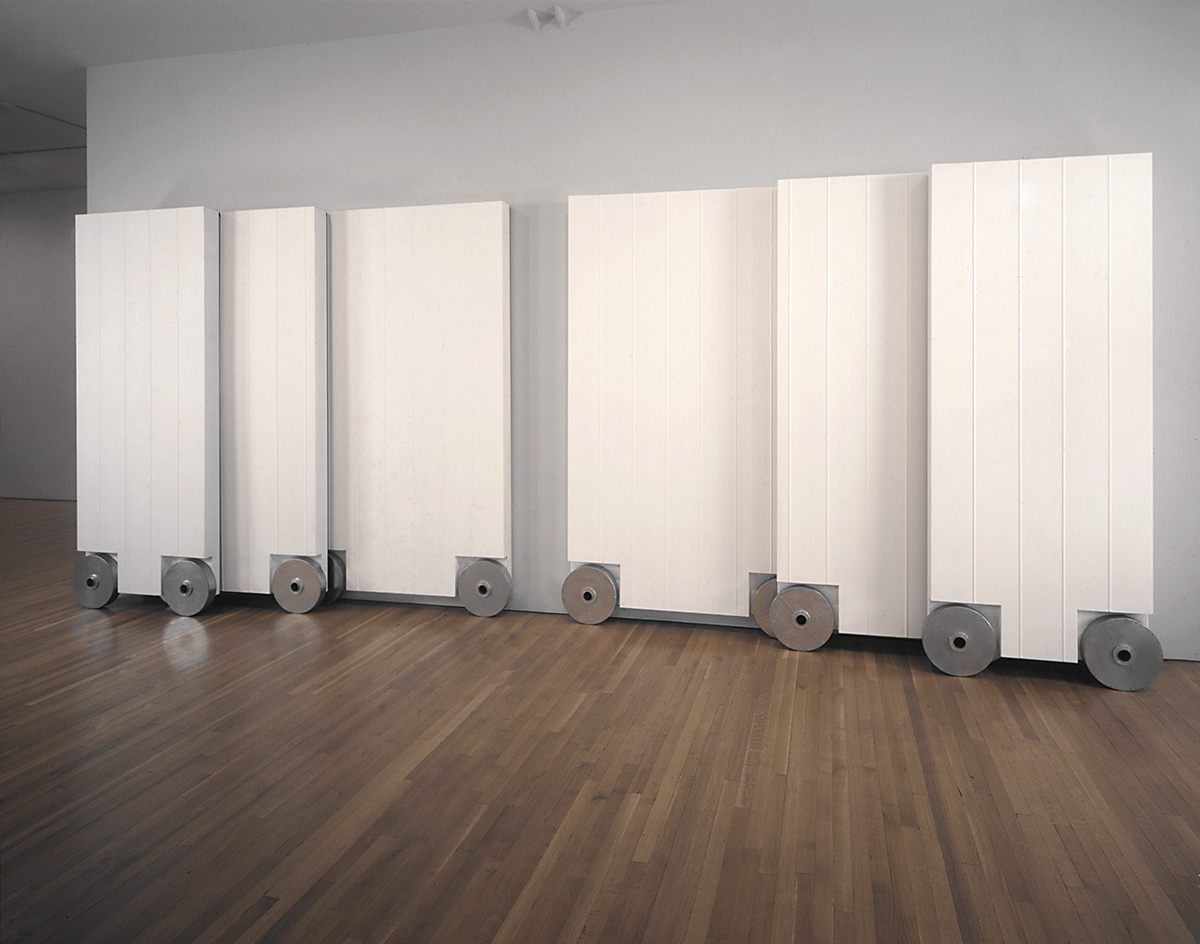
In mechanics the concept of symmetry is developed for functional purposes.
In Opera sinistra e opera destra, one of the sculptures Umberto Cavenago presents in this exhibition, the same concept is adopted through a system consisting of six movable scenes moving in a field of existence varying from four to twelve metres.
It is a unique work made up of six elements and in this particular case has been installed in such a way that it is visually divided into two parts. In fact, three of the backdrops which make up half of the work and which open symmetrically and mirrorly to the others, are placed in a hall of the gallery, and the other three are located in a room adjacent to the first, but not communicating with it.
The work is divided by a wall that irremediably fragments the work and prevents its complete perception. While the sculpture ideally maintains its formal unity, at the same time it transforms itself precisely according to the architecture in which it is situated. Opera sinistra e opera destra, as often happens in all of Cavenago’s works, (think of L’Arte stanca created at the Pecci Museum in Prato in 1993) drastically interact with the space in which it finds itself precisely because it was conceived with a view to a potential reorganization and restructuring of it.
At the same time, the work is influenced by the place and allows itself to be contaminated by it, so much so that it adapts and transforms itself continuously. The white colouring with which the surface of the work is rigorously treated highlights even more the identification effect that arises between it and the background wall on which it rests.The difference with the support at this point becomes really thin if it weren't for the slight three-dimensionality created by the overlapping of the backgrounds. The slide along the wall and the possibility of expansion inherent in the sculpture, which can occupy a width of twelve metres, also implies a continuous oscillation between a more monumental dimension and a totally opposite one based on the desire for emptiness and absence.
The relationship with the place becomes even more intense from the moment the object moves. Movement in this case becomes a metaphor for the development of thought and highlights the importance that the artist attaches to this element: “...movement is the only definitive thing in the existence of man”. It also implies a reaction on his part to the traditional idea of sculpture seen as something static and definitive.
Along the surface of every fifth run a series of grooves that recall in their rhythm of full - empty, the principle of classical architectural composition.
At the same time, if on the one hand the work seems to become architecture itself, on the other hand the fact that it is provided with small wheels applied to the base of every fifth gives it an additional function that escapes and goes beyond the traditional function of architecture.
Opera sinistra e opera destra now acquires a symbolic function in an unconventional field which is that of art. It acts as a support, albeit fragile and not definitive, for an elusive and constantly changing system.
Saldatura, catalogue text by Antonella Soldaini
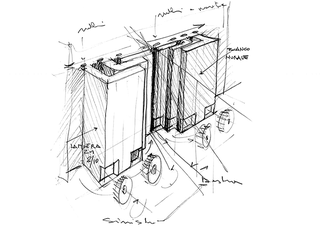
Drawing of the project
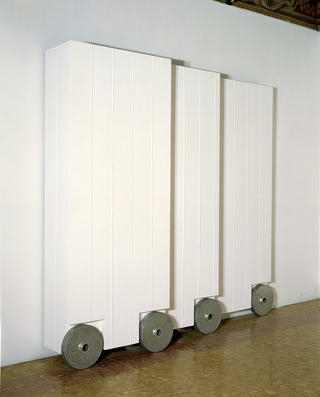
Installation at La Nuova Pesa Gallery, Rome, 1994
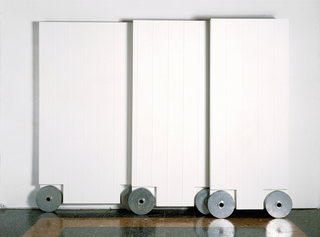
Installation at La Nuova Pesa Gallery, Rome, 1994
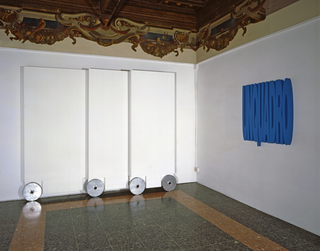
Installation at La Nuova Pesa Gallery, Rome, 1994
On the right wall Un Quadro, by Maurizio Arcangeli
Social
Contatti
umberto@cavenago.info